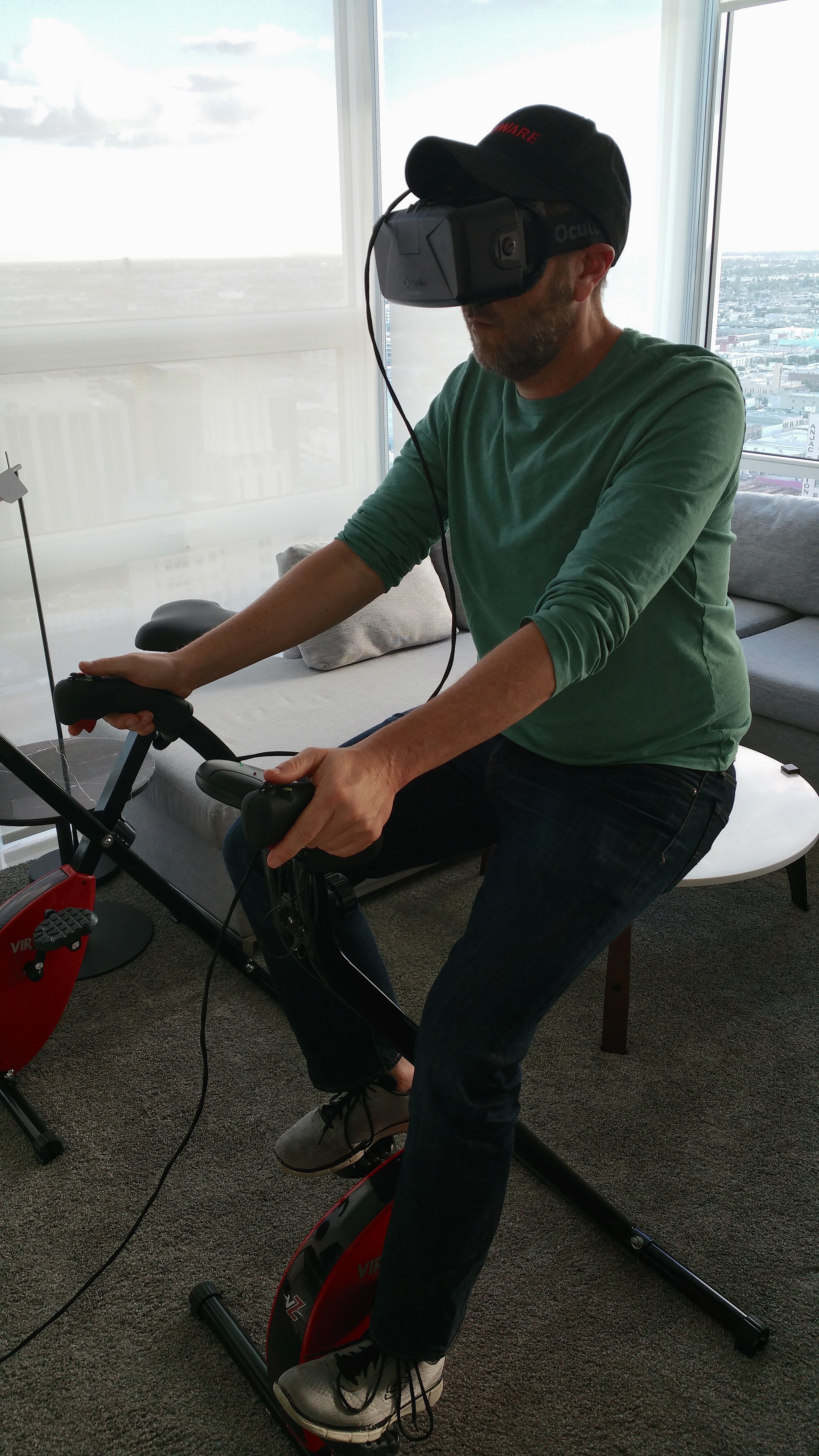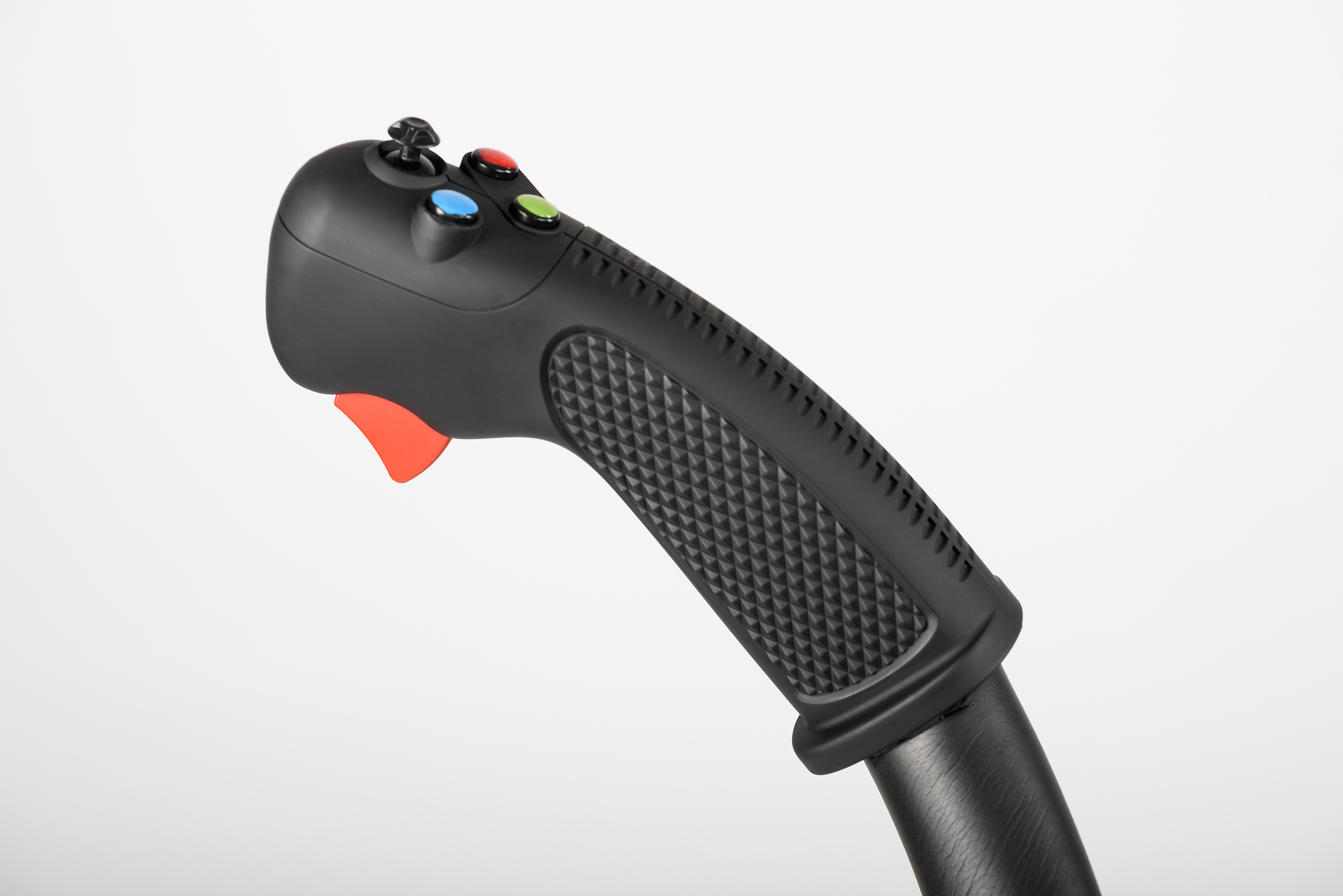Virzoom Rides VR Gaming To Fitness Possibilities (Feet On)
This might be the first article I’ve written and lost weight at the same time, and if virtual reality unlocks the potential that bicycle controller creator Virzoom envisions, it won’t be the last. That's an "if" on top of an "if" given that we can all only speculate and debate the potential success of VR. On the other hand, VR doesn't exist in a vacuum, and its success is also dependent on the success of its ecosystem of content, developers and equipment. Virzoom expects to play a role in all three parts.
Think exercise bike meets VR gaming. Mmm, scratch that. I almost lost you, didn't I? Like everything in the fast-emerging new world that is still more virtual than reality, explaining it is always the most difficult part.
On paper, Virzoom sounds like a trick to make you exercise by sprinkling in a little gaming, kind of like when your mom crushed up aspirin in apple sauce. In a way, that is actually what’s happening here, only instead of applesauce it’s chocolate cream pie. These games are fun, there are more on the way, and, hell, they may just get you to exercise. What's not to like?
The Hardware
Let’s start with the scary part (for some of us), the bicycle. It looks and feels just like your (or your neighbor's) standard home exercise bike. It weighs about 38 pounds and takes up about two feet of floor space from side to side and 28 inches front to back (13 if it's folded up, which it does, a bit like an ironing board). It's a little more than four feet high. The biggest difference from a normal exercise bike is its extended base, which makes it a bit safer as you look into the VR abyss, rather than the real world. Also, you lean — like on a bike — in order to go left or right, taking your movements a little further afield than they would be on a standard exercise bike. VR HMD position tracking enables this, and the extended base prevents the logical accidental outcome.
The bicycle controller has a variety of sensors of its own, collecting data about how fast you’re going and feeding it back to the game for tighter game control, the rate of change on the bike pedals, and change of direction (backward or forward, obviously). There is a resistance adjustment, and that gets measured too, so that if you’re in a multiplayer game, your opponents will know if you’re taking the easy way out.
The bike’s handles are controller paddles, with buttons for navigating menus and firing missiles, or other acts of playful atrocity. The handles will also have heart rate sensors for measuring calories, distance and time, or if you're super competitive, tachycardia.
The bike's data gets transmitted to either a PS4 (with PlayStation VR) or PC (connected to Oculus Rift or HTC Vive) over Bluetooth (LE), using a special dongle. Remember, all that connection is doing is passing data, so that should suffice. It cannot make use of a mobile VR platform like the Samsung Gear VR, because those lack positional tracking.
Get Tom's Hardware's best news and in-depth reviews, straight to your inbox.
In the demo I experienced, we used an Oculus DK2, and it was running off of an Asus laptop with an Nvidia GeForce GTX 970M GPU (the Oculus Rift requires a desktop GTX 970 or above, but Eric Janszen, the company's CEO and co-founder, indicated that the Virzoom VR games run fine on the mobile GPU).
The Games
Now the fun stuff. Virzoom has its own development team and had three games ready for demonstration. It will have five by launch. These games are intended to inject some interval training with a little fun, much like Dance Dance Revolution made its players more active, Janszen reminded me.
Virzoom developed its games using the Unity game engine, and it has also created an SDK for its controller. Janszen said that developers using the Unity engine and VZ SDK can target the bike platform, including games already built using Unity, as long as those games were built from the ground up for VR. I asked about other game engines, and Janszen said that Virzoom is open to it but has no existing plans beyond Unity right now.
Back to the games. These aren’t some fake bike tours on fake roads. One game, called Stampede, had me chasing bandits on horses. The faster I pedaled, the closer I got to them, leaning left or right to align myself and then using the trigger to lasso them off their horse. And onto the next bandit.
Another game, called Go Fast Car, had me pedaling to race other cars. I could use the handlebar controller trigger to slow down on turns and then accelerate on the straightaway, leaning left and right to get in between the other cars. At the end of this game, when all of the noise had stopped, I could hear myself breathing heavily. And that was after a loss.
The last game I played, Pegaso, was more like an open world environment, with me atop a Pegasus, taking off into the sky higher and higher the faster I pedaled. When I slowed down, I lost altitude. In each game (there are a few), the object was to collect gems or energy packets to score points or simply keep going, sometimes in a predetermined amount of time. Grabbing gems and packets at varying distances and different altitudes made for some interesting maneuvering up and down, pedaling faster or slower or leaning side to side, depending on what was necessary. (Talk about interval training.) When I finally removed the DK2, I realized I was perspiring.
Only once during these games did I get a little dizzy; it happened when I let my Pegasus drop to the ground abruptly on an incline — in other words, my horizon was unclear, I was in a first person mode, and the object I was on (virtually) moved quickly. That's your basic recipe for nausea. So avoid that.
Availability And Price
Starting today, the company is taking pre-orders for the bike on its web site. It’ll work like this: The first 300 orders will get the bike and the five initial games, and any updates of those games over time, for $199.95. After those go, it’s $249.95. Given that none of the marquee HMDs -- the Oculus Rift, HTC Vive, or the Sony Playstation VR -- are actually shipping at present, the pre-ordering is a little baffling. Janszen pointed out that the Virtuix Omni (a VR treadmill that costs a fair bit more than Virzoom) has about 4,000 pre-orders. So what do I know? (A $1,000-plus PC, a fill-in-the-blank-check Rift, a $250 bicycle controller. In for a dime, in for a dollar.)
Also, the company is only saying that the Virzoom will ship in the first half of 2016. A curious thing, though: The company is calling those first 300 units "beta units" and also "early access." In full, CEO Janszen said: "Potentially all 300 beta units (both the first 300 early access as well as later units) will be used by owners of the approximately 200,000 DK2 units shipped (per Oculus’ public estimates) and then later used with CV1, PSVR, and Vive when these products become available." I'm admittedly reading between the lines, but he seems to be saying that the Virzoom beta units could ship before the Oculus Rift (CV1), which either means customers will get them early in 2016, or CV1 is coming late. Or it could just mean that DK2 customers will wait to buy the official CV1.
But there’s more. The company believes there’s a subscription model to be had. For $9.99/month (Virzoom Plus) you get the games, including new versions of them (new races, new cars, new characters, and so on), new games for free, and the fitness data tracking app (just buying the bicycle controller without the subscription fee gets you the heart rate monitoring and data). The app tracks the data over time, and versus others, with goal setting and other aspects you’d see in a FitBit. (In fact, Spencer Honeyman, the company's director of business development, told me there are talks with FitBit).
Finally, you get online multiplayer capabilities with the subscription. The company thinks there will be an eSports competitive element to this. When you buy the bicycle controller, you get the subscription service for free for a month to try out.
The Virzoom is a simple exercise bike intended for the mass market. It isn’t designed as a high-end bike for serious riders and training. The early adopter, Janszen believes, is going to be the gamer.
Fritz Nelson is the Editor-In-Chief of Tom's Hardware. Follow him on Twitter, Facebook and Google+. Follow us on Facebook, Google+, RSS, Twitter and YouTube.
-
Pedasc It would be nice if this allowed the games to vary the resistance to give it a bit of feedback. Good idea though, I hope they do well and I might consider this after all the VR headsets come out..Reply




